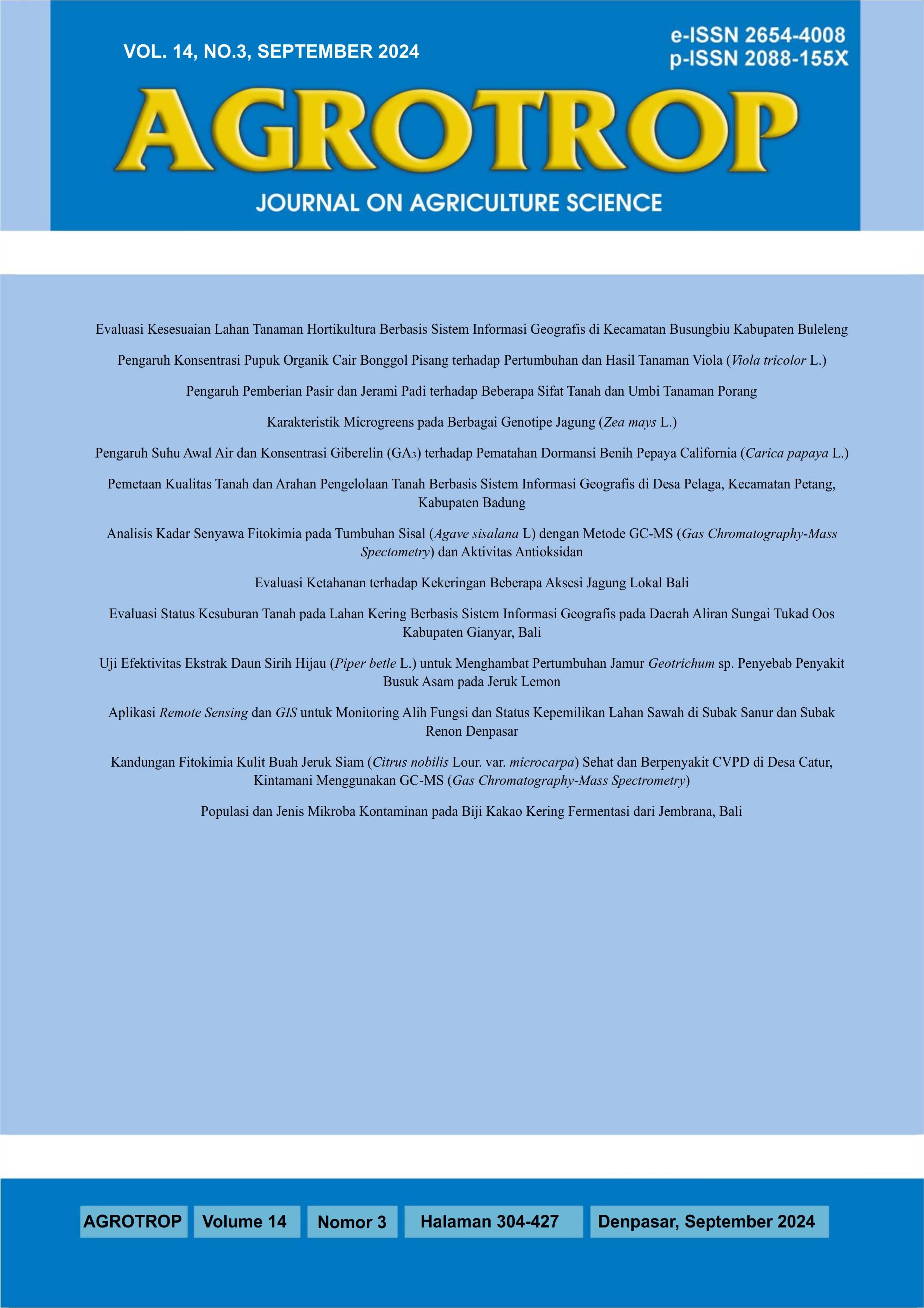Uji Efektivitas Ekstrak Daun Sirih Hijau (Piper betle L.) untuk Menghambat Pertumbuhan Jamur Geotrichum sp. Penyebab Penyakit Busuk Asam pada Jeruk Lemon
Abstract
Effectiveness of Green betel (Piper betle L.) Leaf Extract to Inhibit the Growth of the Fungus Geotrichum sp., the Cause of Sour Rot Disease in Lemon. Sour rot disease, caused by the fungus Geotrichum sp., is an important post-harvest disease of citrus fruits in most parts of Indonesia and the world. Therefore, it is necessary to develop environmentally friendly disease control methods, one of which is by using botanical pesticides. Green betel leaf is one of the plants whose extract is used as a botanical fungicide. This study aims to test the effectiveness of green betel leaf extract against the fungus Geotrichum sp., which causes sour rot disease in lemon. The colony test uses eight extract concentrations, namely 0,8%, 0,16%, 0,32%, 0,40%, 0,48%, 0,56%, 0,64%, and control. The in vivo test uses five concentrations, namely 0,5%, 0,75%, 1%, 1,25%, 1,5%, and control. The research results showed that the minimum concentration of green betel leaf extract that suppressed the colony growth of the fungus Geotrichum sp. is 0.40% which means it is suitable for use as a botanical fungicide. On in vivo test, green betel leaf extract inhibits fungal growth and infection and can suppress the growth of Geotrichum sp. An extract concentration of 1,5% can suppress the damage of lemons by Geotrichum sp., amounting to 47.16%.
Downloads
References
Ali, I.F.G, K.A. Suri, B.D. Gupta, N.K. Satti, P. Dutt, F. Afrin, G.N. Qazi, and I.A. Khan. 2008. In Vitro Antifungal Activity of Hydroxychavicol Isolated from Piper betle L. Annals of Clinical Microbiology and Antimicrobials. 9(7): 1-9.
Eni Kusumaningtyas, R.R. Widiati, D. Gholib. 2008. Uji Daya Hambat Ekstrak dan Krim Ekstrak Daun Sirih (Piper betle) terhadap Candida albicans dan Trichophyton mentagrophytes. Seminar Nasional Teknologi Peternakan dan Veteriner. h. 805-81
Harborne, J.B. 1987. Metode Fitokimia. Institut Teknologi Bandung. Bandung. 62 hal.
Kardinan, A. 2001. Pestisida Nabati, Ramuan dan Aplikasinya. Penebar Swadaya. Jakarta.
Patil, R. S., Harale, P. M., Shivangekar, K. V., Kumbhar, P. P., and Desai, R. R. 2015. Phytochemical potential and in vitro antimicrobial activity of Piper betle Linn. leaf extracts. Journal of Chemical and Pharmaceutical Research. 7(5): 1095- 1101.
Pelczar, M. J., dan Chan, E.C.S. 1986. Dasar-Dasar Mikrobiologi. Jilid 1. Universitas Indonesia. Jakarta
Prabowo, A. 2014. Uji Efektivitas Antimikroba Ekstrak Daun Kemangi (Ocimum x africanum Lour) dan Tembakau (Nicotiana tabacum Linn) terhadap Pertumbuhan Streptococcus mutans secara In Vitro. Skripsi. Universitas Muhammadiyah Purwokerto: Jawa Tengah.
Rahayu, T. 2009. Uji Antijamur Kombucha Coffee terhadap Candida albicans dan Tricophyton mentagrophytes. Jurnal Penelitian Sains dan Teknologi. 10(1): 10- 17.
Rahmah, N dan A Rahman. 2010. Uji Fungistatik Ekstrak Daun Sirih (Piper betle L.) terhadap Candida albicans. Jurnal Bioscientae, Vol. 7, No. 2: 17-24.
Silva, F., S. Feirera, A. Duerte., D.I. Mendonca, and F.C. Domingues. 2011. Antifugal Activity of Coriandum sativum Essensial Oil, its Mode of Action Against Candida Spesies and Potential Synergism with Amphotericin B. Phytomedicine, 19(1): 42-47.
Subhisha, S. and A. Subramoniam. 2005. Antifungal Activities of a Steroid from Pallavicinia lyellii, a Liverwort. Indian J Pharmacol. 37(5): 304-308.
Suprapta, D. N. 2014. Pestisida Nabati: Potensi dan Prospek Pengembangan. Pelawa Sari: Denpasar.











